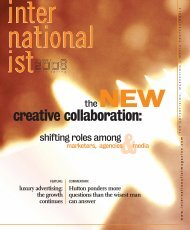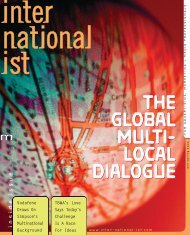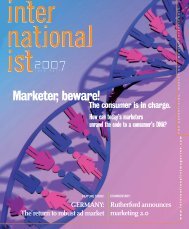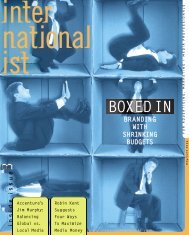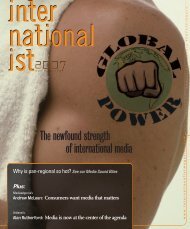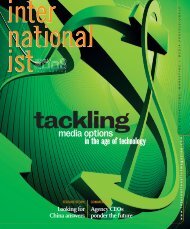Issue 9 - Internationalist
Issue 9 - Internationalist
Issue 9 - Internationalist
You also want an ePaper? Increase the reach of your titles
YUMPU automatically turns print PDFs into web optimized ePapers that Google loves.
C O V E R S T O R Y<br />
The campaigns, below and<br />
opposite, created by Carat,<br />
demonstrate a new kind of<br />
relationship and process, the agency<br />
says. Carat developed<br />
communication strategies and the<br />
media and creative<br />
implementation followed.<br />
In a pan-European<br />
program for Adidas, the<br />
key was building<br />
credibility by forging<br />
close ties with relevant<br />
editorial content. Carat<br />
negotiated and<br />
managed media deals<br />
at the pan-European<br />
level, and the creative<br />
was implemented<br />
by the media owners.<br />
Among them were<br />
sponsorship of National<br />
Geographic’s “Science<br />
of Sport” TV series<br />
across Europe, an<br />
advertorial guide in Elle<br />
about foot care, and<br />
an advertorial fashion<br />
style piece in FHM.<br />
And then there is the independent media<br />
consulting agency Naked, which positions itself<br />
as a media resource that blends the rigors of<br />
account planning, strategy, and innovation from a<br />
creative point of view. Jason Dawes, who left<br />
Adidas as global media manager last year to join<br />
Naked as a partner and to start<br />
up an Amsterdam office, says,<br />
“We’re really excited about<br />
what’s happening in the<br />
marketplace.We are seeing a<br />
real change in how clients are<br />
managing their business.”<br />
Increasingly industry experts<br />
are realizing that “one size<br />
does not fit all,” but it’s not clear<br />
how many different models<br />
the market will bear. And some<br />
clients say they are satisfied with their current<br />
resources. One of those is Bernhard Glock,<br />
manager of global media & communications at<br />
Procter & Gamble and a member of the WFA<br />
media committee, who says,“At P&G, our<br />
agencies have a very collaborative relationship.”<br />
For others though, the industry has yet to<br />
offer the right solution. Dawes says major<br />
change is inevitable.“You’ve got clients<br />
demanding...saying to creative agencies and<br />
media networks ‘we want you guys to work<br />
together.’ Maybe one meeting happens and<br />
not many more.”<br />
Some believe that sometimes it makes<br />
sense for media to drive the process,<br />
especially with so-called new media. McLean<br />
says more and more clients are coming to<br />
media agencies first.“We for many clients<br />
these days provide input into the creative<br />
brief. It’s absolutely the right way for most<br />
clients because there is no point in putting<br />
creative together unless it’s going to reach<br />
the audience in the right way.”<br />
Andreas Vogiatzakis, managing director<br />
and Taiwan country head for MindShare<br />
Communications, believes media will take<br />
even more control.“It makes more logical<br />
sense,” he says.<br />
Outfin says there are times when her<br />
company takes the lead now, but she points<br />
out that with the broad range of clients<br />
Carat has, there is no single way that works.<br />
“Some [of our clients] are more classical; they<br />
want their marketing teams to drive the process<br />
with their creative agency and want us to do<br />
implementational work and some of our other<br />
clients” want Carat to be part of the entire<br />
process as equal partners with the client and the<br />
creative agency.<br />
She says it’s time for the industry to move on<br />
from turf battles over whether media or creative<br />
comes first and recognize that in reality they go<br />
hand-in-hand.“If ‘creative’ is what you say, then<br />
‘media’ is how you behave,” she says.“They are<br />
intrinsically linked, and both are key influences<br />
on how a brand’s communication is received.”<br />
Carroll, however, says the starting point is<br />
creative. It’s not the core role and responsibility<br />
of media to generate the big brand idea or to<br />
generate the core communications property.<br />
“It’s not their core competence.We would<br />
encourage them to have more creative thinking<br />
in the planning phase. But it still should<br />
start with traditional creative agency. Before<br />
you can invite creative media thinking to the<br />
table, you need to have a brand property to<br />
be discussed,” he says.<br />
That, he adds, is the challenge for the creative<br />
agency: to develop a different kind of creative,<br />
big brand ideas that work across platforms, across<br />
media, across different target groups, across<br />
national boundaries, internally and externally<br />
within cultures.<br />
“Then you need media thinking that can<br />
work creatively and collaboratively with the<br />
creative department to generate the best way of<br />
the engaging the consumer,” he says.<br />
He cites as examples from his own agency<br />
the “Axe effect” for the Unilever’s Axe brand<br />
and “keep walking” for the Johnnie Walker<br />
brand. Ideas like these need to be first developed<br />
as flexible properties not as executions for a<br />
particular medium, he says.<br />
Media specialists aren’t convinced. Media<br />
people are becoming the “general contractors of<br />
the marketing process because they have this<br />
ability to see across a wider perspective than<br />
just advertising,” says McLean.“These days our<br />
customers’ world of communications is very<br />
much bigger and different than just advertising.<br />
20 www.inter-national-ist.com



